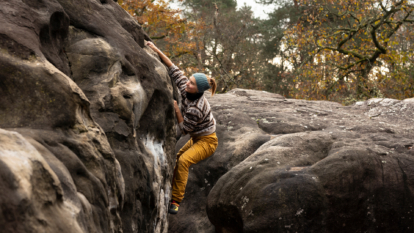Les dons de la forêt
Parfois le seul moyen de devenir plus fort, c'est de lâcher prise.
All photos by Cristina Baussan
The morning light was pink and peach, the air hazy over the dusty expanse of the Cederberg Mountains in Rocklands, South Africa. I knew it was beautiful but was unable to feel it.
It was 2017, and I was standing in front of an orange boulder with perfect crimps in its horizontal breaks. Most of my friends had already climbed it and moved on, and I should have walked away by now, too. Instead, I kept coming back five days in a row, closing my hand over and over on the small shark’s tooth of the crux. I had pain and some odd sounds coming from one of my fingers, but I ignored both.
Once, I managed to get to the top move. A group of spotters—random, supportive, enthusiastic—cheered me on. I reached out for the last hold, a jug from which it was impossible to fall. My fingers touched it. Everybody thought I had it, and then, I fell. The collective groan behind me made me feel like I didn’t deserve to be there.
For a while, I’d been feeling as though I didn’t deserve to be at all.
I thanked my spotters and sent them on their way. I didn’t want anyone to witness the sad spectacle, but my project stood right at the beginning of the sector. Scores of climbers walked past; perhaps put off by my demeanor, none of them stopped. Each time, I breathed a sigh of relief.
I pulled on again and again, while my brain went around in mad circles and my finger joint kept making its smacking sounds. Then, a sharp pain followed by a rapidly spreading numbness across my palm sobered me up.
Was it the disappointment that made me cry? Injured, at least I had an excuse for my inadequacy.
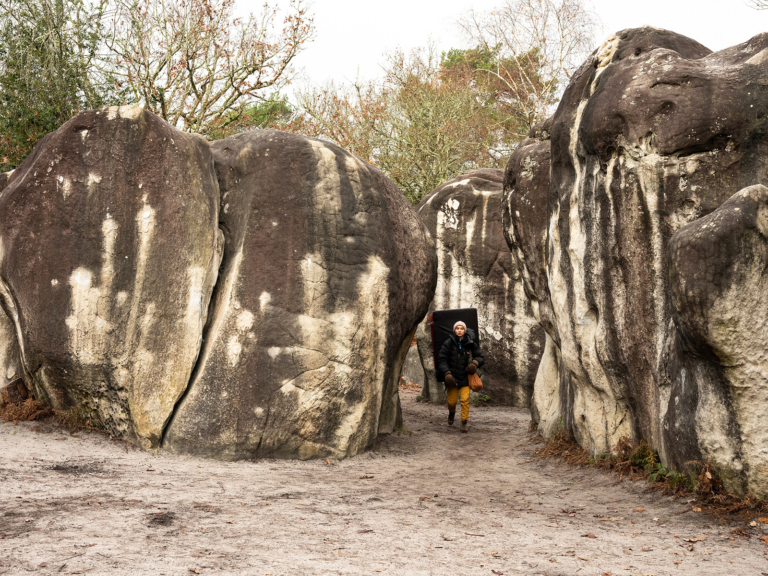
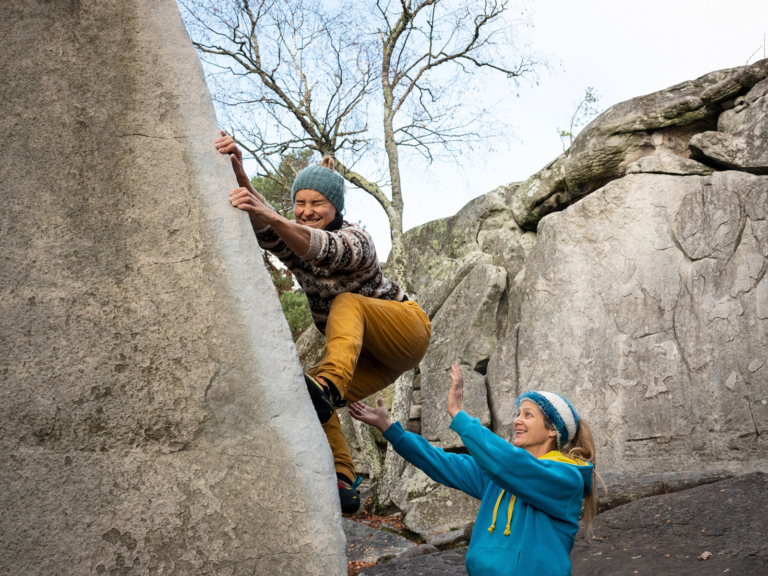
Helen Dudley spots Zofia Reych. A dear friend of Zof and a lifelong climber from England, Helen made the Fontainebleau Forest her home, like many others from all over the world.
Not long after returning home from South Africa, I was at a doctor’s appointment in Poland that had nothing to do with my fully ruptured A2 pulley. The waiting room in central Warsaw was small but smart, with a faux-leather sofa under an industrial-style clock. The receptionist’s unnaturally calm voice sounded as if they half expected me to require a straitjacket. Pretending to browse a magazine offered on a coffee table, I fought a growing urge to leave when a door opened and I was called in.
The plain office was comfortable—impersonal but not clinical. The doctor wore a striped T-shirt and jeans, his tattooed forearm partially hidden by his laptop. He seemed very normal, and I felt normal too, so what was I here for? I felt the urge to leave again but pushed it away. It wasn’t my first appointment but the last in a series of diagnostic meetings, and each time I had felt slightly less out of place. Not today.
Still, I answered the doctor’s questions methodically. Perhaps I only imagined a knowing smile on his face, as if he saw something obvious yet unseen by others. In truth, I saw it, too. The diagnosis that followed was more a confirmation than a revelation.
Unmanaged for the duration of my lifetime, autism spectrum disorder had left me balanced precariously on the edge of clinical depression. Years of masking my autistic traits allowed me to appear to fit in with society while paying the price in anxiety, meltdowns and ruined relationships. I had no idea that my diagnosis was a turning point—one which I was incredibly lucky to have. Unaware of the gravity of the moment, I walked out with a prescription, the name of a therapist and a recommendation to come back for a checkup.
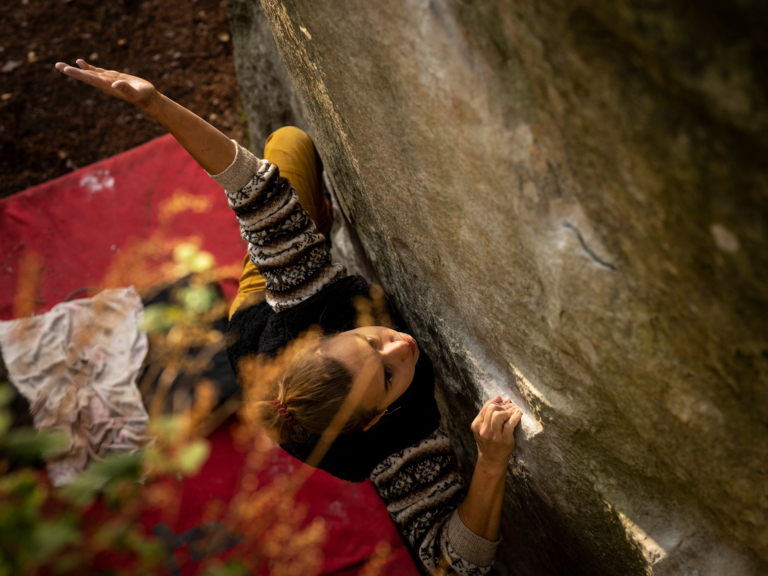
Three years later, I found myself in my newly purchased home in Fontainebleau, France. The window overlooking the messy back garden was new, but the house has been here since 1786, its stone walls made of the same perfect sandstone as the boulders hidden among the pine forest surrounding it. Sitting at an improvised desk, I looked out toward the forest, then back at the blank Word document glaring on my computer screen.
The Fontainebleau Forest is a culture and tourism hub just north of Paris, with activities ranging from art-gallery auctions to mountain biking. Among climbers, it is famed for being the oldest bouldering destination with the greatest concentration of lines in the world. It is the mecca visited year-round by climbing pilgrims from across the globe. And, as the cold and humidity strike the perfect balance for a few days each winter, the hardest problems in the world get put up by the strongest athletes.
A couple of years into my Fontainebleau life, the world stopped turning. Pandemic lockdown confined me and my partner to our newly bought house. It was a luxury I was fully aware of, but the human brain, or at least my brain, is not wired for contentment. The DIY stores were closed. The forest was off limits, professional and amateur climbers were gone, only birdsong filled the woods. Suddenly, my raisons d’être—climbing as hard as I could and renovating our home in the meantime—were taken away.
The most obvious reaction would have been to throw myself into training, but I was exhausted. Not by climbing, or pull-ups, or finger-boarding, or by measuring my progress in detailed spreadsheets. I was exhausted by the need to validate myself through achievement: in climbing, renovation work and, in fact, everything I did. I’d set impossible goals that moved further away each day, and I could not sustain them any longer. Much like in Rocklands, I was bound for failure, but this time it wasn’t a boulder problem on the line, it was my life.
Without knowing what else to do, I turned to the one thing I’d always done. Before work, school and climbing, before learning how to lay parquet flooring and lying awake at night out of fear of putting it down askew, I had been a writer. If I’d been one at 4 years old, clumsily binding my completed pages together with a needle and thread, maybe I could be one again. Three decades later, confined to a dilapidated house, surrounded by a forest that was suddenly empty, it was the only thing I could think of.
Like many times before, I started writing, but this time I clung to it as though it were a life raft.

I spent the better part of two years writing and researching climbing’s history and culture, but barely getting out on the rock myself. A layer of writerly chub covered my abs. My back became sore from hours spent at a desk. I couldn’t even pull on to the problems that used to be my projects. But writing changed much more than that.
What happened is almost as cheesy as if I said that I’d learned from the lives of Paul Preuss, Catherine Destivelle or Chris Sharma. (I learned recently that it’s OK for life to be cheesy at times, as much as it’s OK for me not to be an elite boulderer.)
I had moved to Fontainebleau thinking it was the best way to turn my life around, climb an impossibly hard boulder and feel better about myself, but that was far from the medicine I needed. Instead, I had to learn that the saying about the journey and the destination is more than a cliché, and that I needed what I now call—usually only in private—“the gifts of the forest.” I couldn’t see them without stepping away from the attempts to validate myself through climbing.
With time, I relearned how to revel in the landscape without having to fly to the other side of the world. I realized the value of talking to my neighbors, even if it meant having to deal with social anxiety. I adopted stray cats, learned to chop firewood and scrambled barefoot up easy rocks.

It’s been months since my first book, Born to Climb: From Rock Climbing Pioneers to Olympic Athletes, was published. A cultural history of rock and competition climbing, it highlights both the celebrated icons and unsung heroes, and brings to the forefront the experience of the average climber. To my surprise, I was asked to write a short article on how writing Born to Climb changed my own relationship with climbing, and I immediately loved the question. I knew I wanted the piece to be about ease, connection and community, but in telling that story I couldn’t avoid telling another, one of depression, crippling perfectionism and a sense of defectiveness—of a devotion to climbing that wasn’t a way out, but a way to repeat the same script over and over again.
In a way, Born to Climb became my longest and most ambitious project, but this time my motivation was not in proving that I wasn’t a failure, but in the work itself. Writing did for me what climbing couldn’t: It pushed me to take care of myself. I found a great therapist and committed to taking my meds. At night I (mostly) slept, (mostly) too exhausted to worry. I did anxiety management. I went for long walks. I didn’t overtrain. In fact, I barely trained at all, yet I was living and breathing climbing.
Still, no amount of self-care and sunset walks can sort out a brain that needs medical help. Had I not been diagnosed, put on meds and in therapy, it would likely take much longer to recover, if at all, and it is distressing that this kind of support is not readily available to all who need it.
Without it, it’s also very unlikely I would have gotten to the finish line with Born to Climb. I don’t claim that it is a V14 book, but it is simply my book, and the time and effort that went into it felt right. The nice-smelling hardback is a cherry on top.
For a while I worried that if I wasn’t constantly striving to break into another grade, I wasn’t really a climber. I also worried that if Born to Climb didn’t become an instant bestseller, I’d fail at writing, too. Somehow, these thoughts don’t concern me—they don’t ring true anymore.
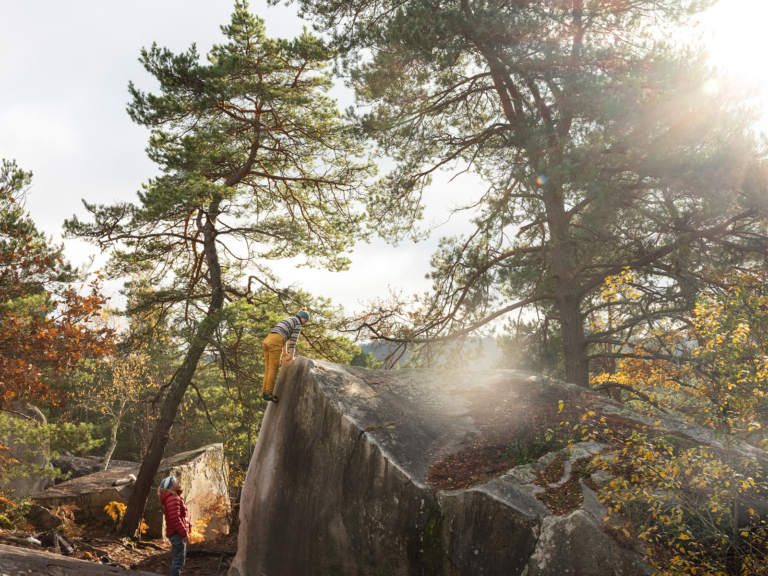
Beyond the window overlooking the messy back garden, I can see the tops of the pines of the Fontainebleau Forest. A sliver of golden light is backlighting low, leaden clouds. Even with so much amiss in the world, the view makes me breathe easy. I am happy. And while it feels like I only know how to write about the bad stuff, as though the good stuff is cheapened as soon as I put it on paper, I have a story to tell.
And then, perhaps I’ll head out to climb.
